Thư viện tài liệu, ebook tổng hợp lớn nhất Việt Nam
Website chia sẻ tài liệu, ebook tham khảo cho các bạn học sinh, sinh viên

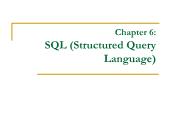 Chapter 6: SQL (Structured Query Language)
Chapter 6: SQL (Structured Query Language)Review questions 1) How do the relations (tables) in SQL differ from the relations defined formally in Chapter 4? Discuss the other differences in terminology.Why does SQL allow duplicate tuples in a table or in a query result? 2) List the data types that are allowed for SQL attributes. 3) How does SQL allow implementation of the entity inte...
 107 trang | Chia sẻ: vutrong32 | Ngày: 19/10/2018 | Lượt xem: 1980 | Lượt tải: 0
107 trang | Chia sẻ: vutrong32 | Ngày: 19/10/2018 | Lượt xem: 1980 | Lượt tải: 0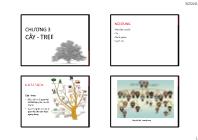 Chương 3 Cây ‐ tree
Chương 3 Cây ‐ treeBIỂU DIỄN CÂY NHỊ PHÂN Biểu diễn cây nhị phân • Dùng cấu trúc liên tiếp (mảng): số lượng nút trên cây chiều cao h là giới hạn (∑ 2i) • Truy nhập nhanh 0(1) • Lãng phí bộ nhớ lớn nếu cây chưa phải là dạng đầy đủ hoặc hoàn chỉnh • Dùng cấu trúc liên kết: thường dùng hơn • Truy cập 1 nút chậm hơn • Tiết kiệm bộ nhớ hơn (trong trường hợp tổng qu...
 10 trang | Chia sẻ: vutrong32 | Ngày: 19/10/2018 | Lượt xem: 965 | Lượt tải: 0
10 trang | Chia sẻ: vutrong32 | Ngày: 19/10/2018 | Lượt xem: 965 | Lượt tải: 0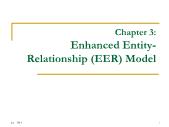 Chapter 3: Enhanced EntityRelationship (EER) Model
Chapter 3: Enhanced EntityRelationship (EER) ModelReview questions 1) Discuss the two main types of constraints on specializations and generalizations. 2) What is the difference between a specialization hierarchy and a specialization lattice? 3) How does a category differ from a regular shared subclass? What is a category used for? Illustrate your answer with examples.
 57 trang | Chia sẻ: vutrong32 | Ngày: 18/10/2018 | Lượt xem: 1636 | Lượt tải: 0
57 trang | Chia sẻ: vutrong32 | Ngày: 18/10/2018 | Lượt xem: 1636 | Lượt tải: 0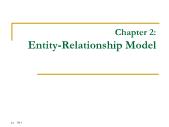 Chapter 2: Entity-Relationship Model
Chapter 2: Entity-Relationship ModelExercise: University Database The university database maintains records of its departments, lecturers, course modules, and students. The university consists of departments. Each department has a unique name and some other descriptive attributes. A department must also have a number of lecturers, one of which is the head of department ...
 70 trang | Chia sẻ: vutrong32 | Ngày: 18/10/2018 | Lượt xem: 1258 | Lượt tải: 1
70 trang | Chia sẻ: vutrong32 | Ngày: 18/10/2018 | Lượt xem: 1258 | Lượt tải: 1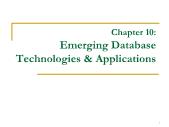 Chapter 10: Emerging Database Technologies & Applications
Chapter 10: Emerging Database Technologies & ApplicationsSummary 1 Distributed Databases & Client-Server Architectures 2 Spatial and Temporal Database 3 Multimedia Databases 4 Geographic Information Systems 5 XML 6 Data Warehousing 7 Outsourcing database services 8 Big Data
 87 trang | Chia sẻ: vutrong32 | Ngày: 18/10/2018 | Lượt xem: 945 | Lượt tải: 0
87 trang | Chia sẻ: vutrong32 | Ngày: 18/10/2018 | Lượt xem: 945 | Lượt tải: 0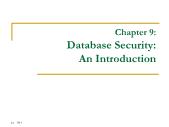 Chapter 9: Database Security: An Introduction
Chapter 9: Database Security: An IntroductionSummary 1 Introduction to Database Security Issues 2 Discretionary Access Control (DAC) 3 Mandatory Access Control (MAC) 4 Role-Based Access Control (RBAC) 5 Encryption & PKI (Public Key Infrastructure)
 83 trang | Chia sẻ: vutrong32 | Ngày: 18/10/2018 | Lượt xem: 1240 | Lượt tải: 0
83 trang | Chia sẻ: vutrong32 | Ngày: 18/10/2018 | Lượt xem: 1240 | Lượt tải: 0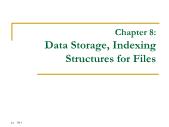 Chapter 8: Data Storage, Indexing Structures for Files
Chapter 8: Data Storage, Indexing Structures for FilesGuidelines for creating indexes Primary and unique keys automatically have indexes, but you might want to create an index on a foreign key. Create an index on any column that the query uses to join tables. Create an index on any column from which you search for particular values on a regular basis. Create an index on columns that are ...
 92 trang | Chia sẻ: vutrong32 | Ngày: 18/10/2018 | Lượt xem: 1106 | Lượt tải: 1
92 trang | Chia sẻ: vutrong32 | Ngày: 18/10/2018 | Lượt xem: 1106 | Lượt tải: 1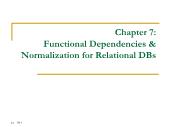 Chapter 7: Functional Dependencies & Normalization for Relational DBs
Chapter 7: Functional Dependencies & Normalization for Relational DBsReview questions 1) Define first, second, and third normal forms when only primary keys are considered. How do the general definitions of 2NF and 3NF, which consider all keys of a relation, differ from those that consider only primary keys? 2) Define Boyce-Codd normal form. How does it differ from 3NF? Why is it considered a stronger form of ...
 88 trang | Chia sẻ: vutrong32 | Ngày: 18/10/2018 | Lượt xem: 1558 | Lượt tải: 1
88 trang | Chia sẻ: vutrong32 | Ngày: 18/10/2018 | Lượt xem: 1558 | Lượt tải: 1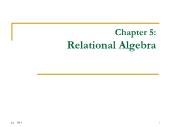 Chapter 5: Relational Algebra
Chapter 5: Relational AlgebraReview questions 1) List the operations of relational algebra and the purpose of each. 2) What is union compatibility? Why do the UNION, INTERSECTION, and DIFFERENCE operations require that the relations on which they are applied be union compatible? 3) How are the OUTER JOIN operations different from the INNER JOIN operations? How is the ...
 82 trang | Chia sẻ: vutrong32 | Ngày: 18/10/2018 | Lượt xem: 1134 | Lượt tải: 1
82 trang | Chia sẻ: vutrong32 | Ngày: 18/10/2018 | Lượt xem: 1134 | Lượt tải: 1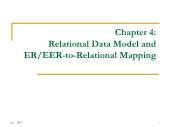 Chapter 4: Relational Data Model and ER/EER-To-Relational Mapping
Chapter 4: Relational Data Model and ER/EER-To-Relational MappingReview questions 1) Define the following terms as they apply to the relational model of data: domain, attribute, n-tuple, relation schema, relation state, degree of a relation, relational database schema, and relational database state. 2) Discuss the entity integrity and referential integrity constraints. Why is each considered important?
 83 trang | Chia sẻ: vutrong32 | Ngày: 18/10/2018 | Lượt xem: 1329 | Lượt tải: 1
83 trang | Chia sẻ: vutrong32 | Ngày: 18/10/2018 | Lượt xem: 1329 | Lượt tải: 1

